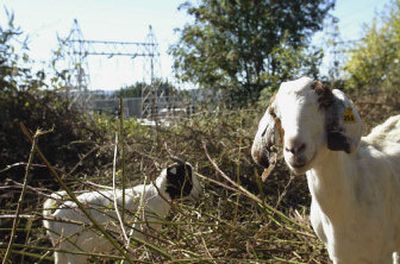Local goat herd draws a crowd while clearing lot in Seattle

An unassuming herd of about 280 goats that call a farm near Edwall home were minor celebrities in the big city of Seattle this week.
Sightseers in the city’s Maple Leaf neighborhood were peeking through a chain link fence for a glimpse at the nannies and kids Wednesday afternoon as herd owner Craig Madsen sat atop his double-decker trailer and watched.
“The goats kind of fit this particular site,” Madsen, owner of Healing Hooves, said as the herd brayed in the background between munches of ivy and blackberry. The goats were working their way around a one-acre parcel of Seattle City Light land near a substation. “This is one of the thickest blackberry projects we’ve been on.”
The area had become overgrown with thick patches of blackberries, so City Light officials decided to utilize a more natural solution.
“The goats are much more adept at working through the thorns,” said Peter Clarke, a spokesman for Seattle City Light. “We felt the normal ways of clearing blackberries wouldn’t work as well. We didn’t even know what was under there. Those bushes were 10 feet high.”
The normal ways of brush clearing would involve hand-clearing – too dangerous on such a steep slope – and herbicides – not healthy for the dozens of homes that surround the substation, Clarke said.
“People are looking for a more environmentally friendly alternative to herbicides,” Madsen said. Western Washington has many strict pollution laws that limit mechanical work near wetlands and the use of chemicals in watersheds. For many landowners, goats are becoming one of the only options for weed removal.
“They don’t have any restrictions on using goats to do the clearing,” Madsen said.
A former range management specialist with the federal Natural Resources Conservation Service, Madsen spends most of his summer traveling from one patch of land to another, transporting the herd of goats in his semitruck. Madsen stays in a sleeper cab at night to make sure the herd stays safe.
He releases the goats into the target area, and the quad-stomached foragers set forth, munching on noxious weeds and helping reduce thick undergrowth. Goats can eat plants that cows can’t and appear to have a fondness for the most noxious of weeds. The herd is composed of females and their kids – no breeding is allowed until October.
There are tricks to the trade – notably involving transportation.
“It’s easy to get them out,” Madsen said. “It’s a lot harder to get them back into the trailer. It took a while to learn that one.”
The herd has traveled to sites all across Washington and North Idaho, with work ranging from a small, acre-sized plat to 25-acre undergrowth removal.
Madsen said he grew tired of working for the NRCS and so after seeing presentations on people using goats for vegetation management, in 2002 he started his own herd of goats.
“It took a number of years to make it come together,” Madsen said. “The challenging part has been selling it. Nobody had used goats in Washington, and people weren’t familiar with it.”
Though the business started slow, now the herd is always on the move, with a full schedule from the end of May through the first part of October.
“I’ve had a couple breaks, two or three days off here and there,” Madsen said. Otherwise, the goats get an endless supply of tasty toadflax and knapweed.
Madsen said some land-grant universities are doing research into how animals such as sheep and goats can clear large areas of land of noxious weeds and keep undergrowth down in forests.
“It’s starting to be looked at a little more seriously than it has been in the past as being a viable tool,” Madsen said.